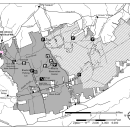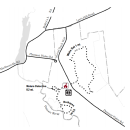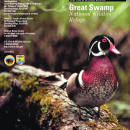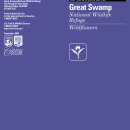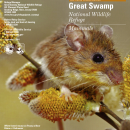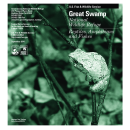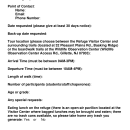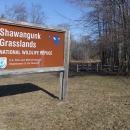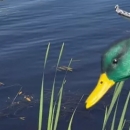Visit Us
National wildlife refuges offer us all a chance to unplug from the stresses of daily life and reconnect with our natural surroundings. People are encouraged to observe, study, photograph and walk with nature in designated public areas. The best times for observing wildlife are early in the morning and late afternoon. Because of large number of visitors in the spring and fall, wildlife viewing on Sundays is often less rewarding. The refuge has close to 11 1/2 miles of foot access trails, with varying difficulty from which wildlife can be viewed. There are also three wildlife observation blinds and one wildlife overlook. Pleasant Plains Road is a good place to view wildlife from your vehicle.
Activities
The refuge offers a variety of wildlife-dependent recreational activities that visitors may enjoy. The refuge supports most of the Big Six wildlife-dependent uses involving hunting, wildlife observation, photography, interpretation, and education.
For school educators or scout leaders interested in a guided group tour for their students or scouts, please fill out this application and email it to Jared_Green@fws.gov
Trails
The refuge has close to 11 1/2 miles of foot access trails, with varying difficulty from which wildlife can be viewed. There are also three wildlife observation blinds and one wildlife overlook. Pleasant Plains Road is a good place to view wildlife from your vehicle.
Related Documents
Other Facilities in the Complex
Great Swamp is managed as part of the Lenape National Wildlife Refuge Complex. A National Wildlife Refuge Complex is an administrative grouping of two or more refuges, wildlife management areas or other refuge conservation areas that are primarily managed from a central office location. Refuges are grouped into a complex structure because they occur in a similar ecological region, such as a watershed or specific habitat type, and have a related purpose and management needs. Typically, a project leader or complex manager oversees the general management of all refuges within the complex and refuge managers are responsible for operations at specific refuges. Supporting staff, composed of administrative, law enforcement, refuge manager, biological, fire, visitor services, and maintenance professionals, are centrally located and support all refuges within the complex.
Other refuges in the Lenape Complex include: Cherry Valley NWR, Shawangunk Grasslands NWR, Wallkill River NWR.
Rules and Policies
Visitors are responsible for knowing all refuge regulations. If you are unsure, please inquire at the refuge headquarters.
Locations
Know Before You Go
- You should start your visit at the Helen C Fenske Visitor Center open Tuesday, Thursday, Friday, Saturday, and Sunday from 10am to 4pm to orient yourself to the refuge. (32 Pleasant Plains Rd. Basking Ridge, NJ 07920). There you can learn the history and find where the wildlife hotspot of the day is.
- While out on the refuge, waterproof footgear or old sneakers are recommended during most seasons in the Wilderness Area. Mosquitoes, ticks, and deer flies may be numerous from May to September throughout the refuge, so insect repellent and protective clothing are advisable. Ticks can transmit Lyme disease, which has been found in the area.
Frequently Asked Questions
1. When is the Great Swamp Open?
The Great Swamp National Wildlife Refuge is open year-round from sunrise to sunset, seven days a week (please be aware that refuge gates open later in the morning or may close earlier in the evening, so access by foot may be required). Occasionally, the refuge is closed due to special events or hazardous weather conditions (e.g. flooding/snow).
2. What is there to see?
People are encouraged to observe, study, photograph and walk with nature in designated public areas. The best times for observing wildlife are early in the morning and late afternoon. Because of large number of visitors in the spring and fall, wildlife viewing on Sundays is often less rewarding. The refuge has close to 11 1/2 miles of foot access trails, with varying difficulty from which wildlife can be viewed. There are also three wildlife observation blinds and one wildlife overlook. Pleasant Plains Road is a good place to view wildlife from your vehicle. The Great Swamp National Wildlife Refuge also recommends that you visit the Raptor Trust (for information please call 908-647-8211), the Somerset County Environmental Educational Center (for information please call 908-766-2489) and the Morris County Outdoor Education Center (for information please call 973-635-6629). There is also the Watchung Reservation, Morristown Historical Park, Sherman Hoffman Audubon Center and several other outdoor recreation areas located close to the Great Swamp National Wildlife Refuge.
3. Do you give tours? Do you have guides? Do you have programs for children?
The Great Swamp National Wildlife Refuge has a small staff and limited availability to give tours and educational programs to school groups. Please contact Jared_Green@fws.gov at least thirty days in advance to schedule a tour or program. Each request will be evaluated on an individual basis depending on staff and volunteer availability.
4. Where can I go to see particular birds or animals?
The most popular places to see birds and mammals are the drive on Pleasant Plains Road and the wildlife observation blinds at the Wildlife Observation Center. For viewing reptiles and amphibians, the boardwalks at the Wildlife Observation Center is the best area.
5. Can we fish, camp or boat? Where can we do these activities?
There is no camping, fishing or boating allowed on the refuge Two county parks in the area that do allow camping by permit are Mahlon Dickerson and Lewis Morris Park. For information please contact the Morris County Park Commission at 973-326-7600. State areas that allow camping and other out door activities can be found by calling 1-800-2-CAMPNJ. For hunting and fishing information in the state, please call 609-292-2965 or go towww.state.njus/dep/fgw. For boating information please contact the Somerset County Environmental Education Center at 908-722-1200, extension 5002.
6. May I bring a pet?
Pets are not allowed on the boardwalks at the Wildlife Observation Center and pets are not allowed on the hiking trails. Pets are only allowed on a leash, not to exceed 10 feet, to walk along Pleasant Plains Road and in parking areas. In general, pets are not encouraged due to their potential to disturb wildlife. Service dogs are welcome at all areas of the refuge open to the public.
7. Can we bike or roller blade?
Biking and roller blading are not allowed on refuge trails. Biking is allowed along Pleasant Plains Road which is unpaved for most of its length through the refuge.
8. What shall I do with an injured bird, animal or amphibian?
If you have found an injured bird, you should call the Raptor Trust at 908-647-2353. For all other wildlife, visit the NJ Division of Fish and Wildlife website for a list of approved rehabilitators by county or by species (http://www.state.nj.us/dep/fgw/rehablst.htm) . You may also call for help. For an injured, nuisance or orphaned young mammal(s), call the New Jersey Division of Fish, Game and Wildlife at 908-735-8793. For snakes, turtles, frogs, birds and other animals; call the New Jersey Division of Fish, Game and Wildlife, Endangered Species and Nongame Program at 908-735-8975. Otherwise, contact the local animal shelter: St. Hubert's Giralda Animal Hospital at 973-377-2295. If you have nuisance Canadian geese or bats, please call the Department of Agriculture, Animal and Plant Health Inspection Service, Animal Damage Control at 908-735-5654. Please be advised that our policy does not permit refuge staff to relocate or assist injured wildlife on public roads or private property.
9. Do you sell Senior or Annual Inter-agency America The Beautiful Passes?
No

